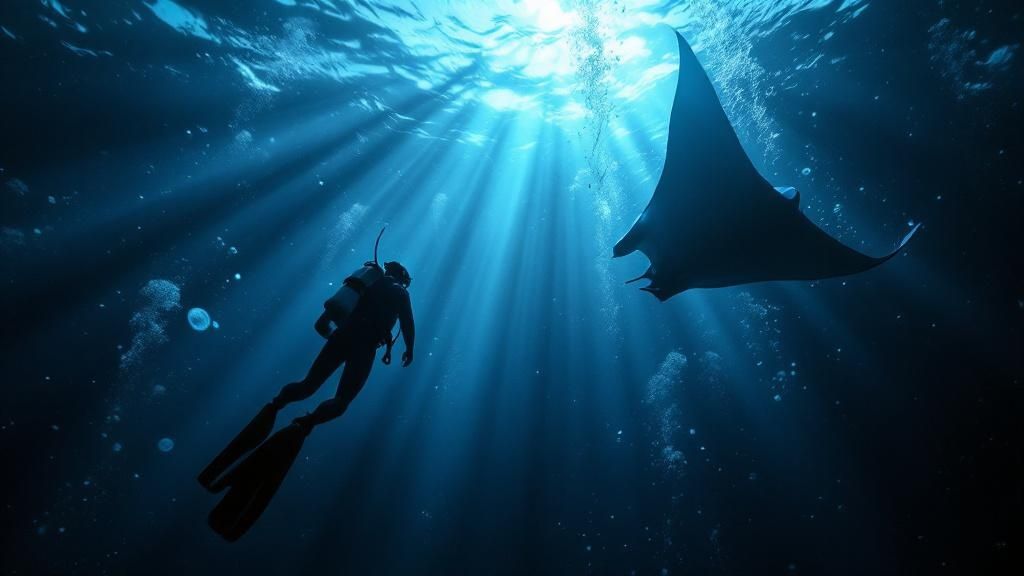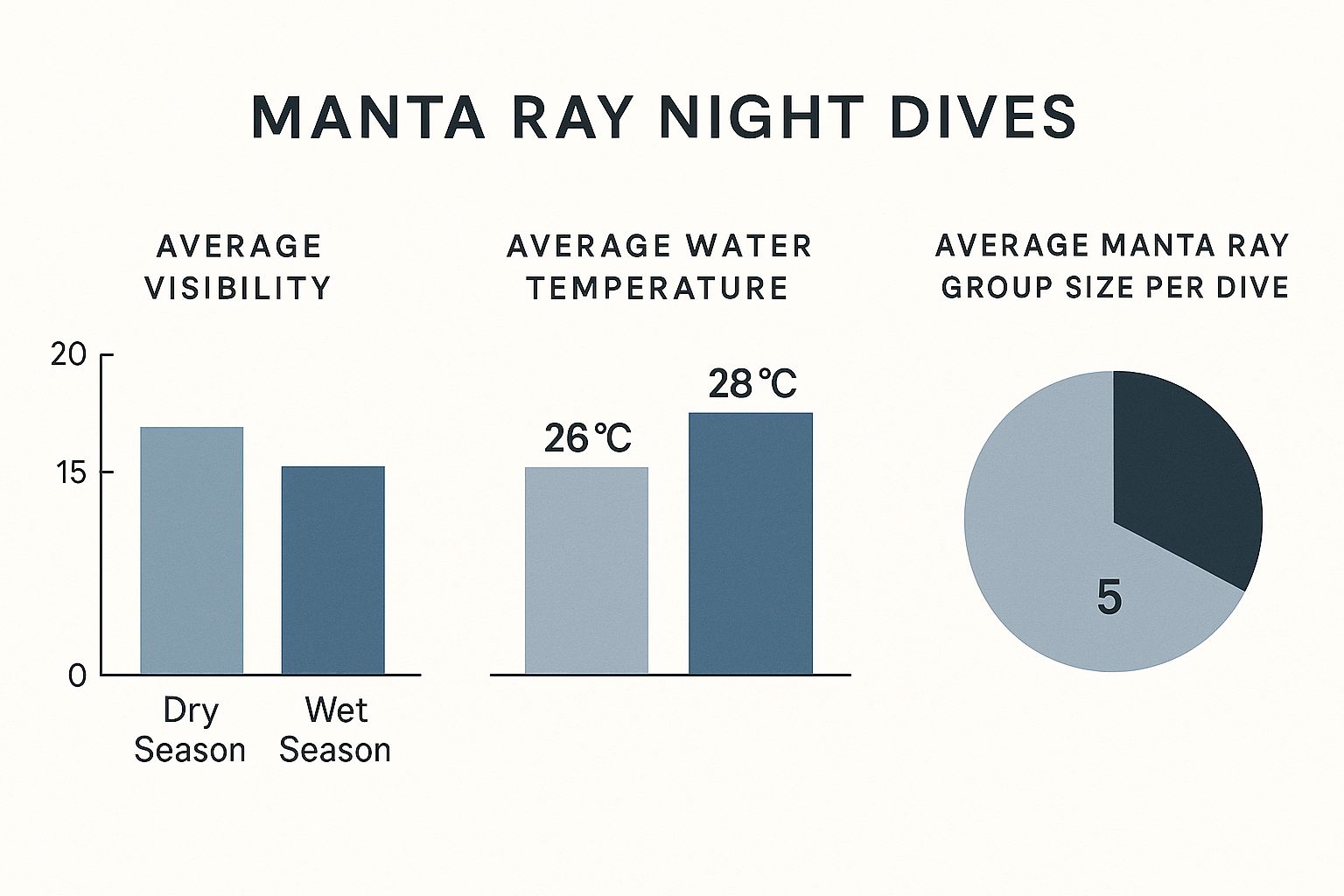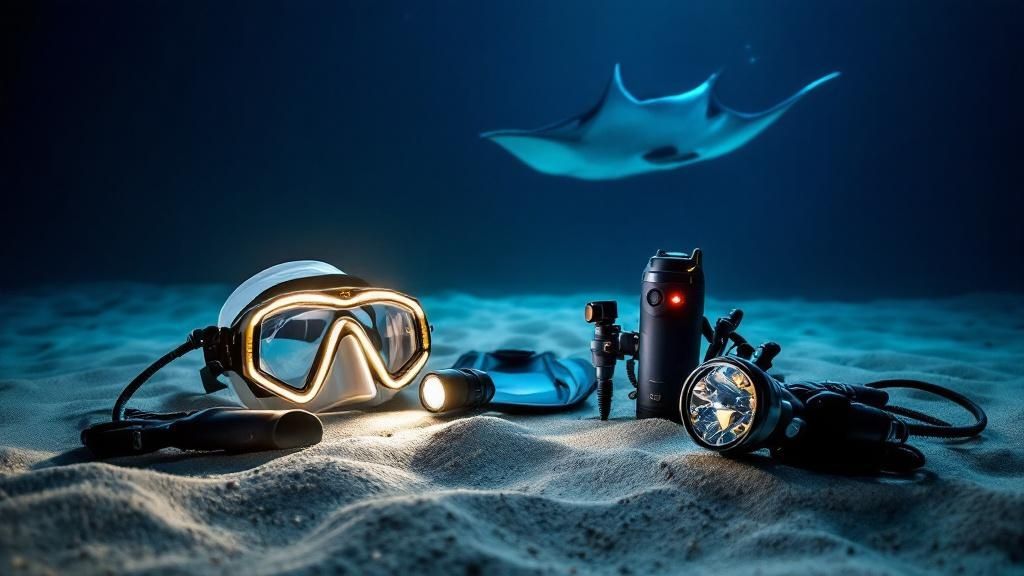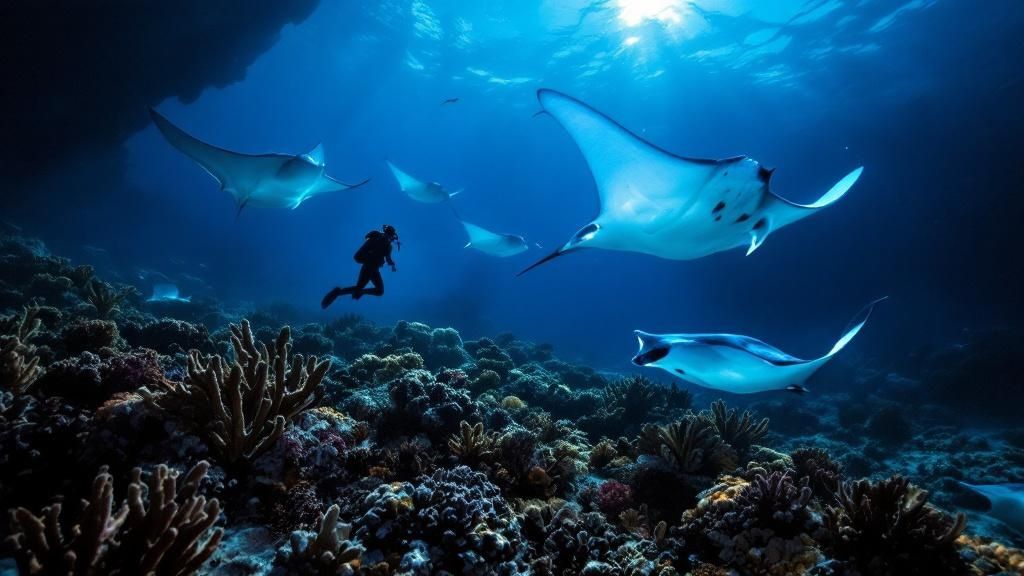Why This Underwater Experience Changes Everything
Imagine floating in the dark depths of the Pacific, stars twinkling above you, and something even more magical happening below. Out of the darkness glides a giant manta ray, its wingspan broader than a car, its white underside glowing like a moon. This isn't a fantasy—it's the wonder of a Big Island manta ray night dive.
What makes this experience so special? It's not just passively watching these gentle giants. The dive is designed to bring them to you. Picture it like an underwater buffet under a spotlight.
Powerful dive lights, placed on the ocean floor, attract tiny plankton, the manta rays' main food source. This sets off a feeding frenzy, luring the mantas close and giving divers an amazing chance to see their graceful movements. They do acrobatic loops and barrel rolls, mouths wide open, as they feast on the plankton.
This predictable feeding pattern is why the Big Island is one of the best places in the world for manta ray night dives. With a sighting success rate of about 85-90%, these dives almost guarantee you'll see mantas, although how many varies each night. This consistency is due in part to the plentiful plankton, which attracts the manta rays for their nighttime meals. The Kona Coast, particularly places like Garden Eel Cove and Keauhou Bay, are famous for these encounters. Many operators prefer Garden Eel Cove because it’s more sheltered and has more mantas. Discover more insights about manta ray sightings.

The Impact of Tourism and Research
The magic of these dives goes beyond a single person's experience. As the Big Island manta ray night dive becomes more popular, it's also fueling more research and conservation work. Think of each diver as a citizen scientist, helping us learn more about these animals. Every photo, every observation, helps researchers identify individual mantas, study what they do, and understand the problems they face.
Understanding the full effects of tourism is vital; you can read more about the connection between marine conservation. You can also learn more about Big Island manta ray night dives with Kona Honu Divers. These dives are more than just a show; they’re a glimpse into a delicate ecosystem and a way to help protect it. When you pick a responsible operator dedicated to sustainability, you're directly helping to protect these amazing animals and where they live. This turns a simple tourist activity into a meaningful experience with nature, leaving you with a deeper respect for the ocean and all the life within it.
Meet Your Underwater Neighbors: The Science Behind The Magic
Each manta ray gracefully navigating the dark waters of a Big Island manta ray night dive has its own unique story. Marine biologists have spent decades piecing these stories together, building something akin to an underwater social network. Imagine each manta's distinct belly pattern as a fingerprint – a natural identifier that allows researchers to track individuals. This helps them learn about individual manta personalities, favorite dining spots, and even social bonds over time.
Some mantas, for instance, exhibit natural curiosity and seem to enjoy interacting with divers, swimming close and circling in what looks like playful behavior. Others are more shy, preferring to watch from afar, gliding along the edges of the illuminated feeding area. Through careful observation, scientists have uncovered fascinating insights into manta ray society.
These gentle giants establish complex social structures, show clear preferences for certain feeding spots, and even display behaviors suggesting a greater level of intelligence and emotional depth than previously thought.
Unraveling the Mysteries of Manta Behavior
So, how do researchers actually study these animals? It involves considerable patience, long nights, and specialized underwater photography gear. Divers and researchers collaborate, meticulously documenting each manta's markings, behaviors, and interactions with other mantas and the environment. This information is then compiled into comprehensive databases, allowing scientists to track individuals over extended periods and paint a more complete picture of their lives.
This research reveals a surprisingly intricate world below the surface. Mantas don't just randomly congregate to eat; they exhibit social hierarchies, preferences, and even what seem to be individual personalities. This deeper understanding transforms a Big Island manta ray night dive from simple observation into a truly meaningful experience. You begin to appreciate not just the spectacle of the feeding, but the individual dramas playing out within it.
From Observation to Connection
The Kona manta ray population is estimated at over 450 individuals, making it one of the largest known groups worldwide. Night dives usually happen at depths of 30-40 feet, allowing for longer dive times and a more immersive experience in the shallow water. Learn more about the Kona manta ray night dive here. The dives themselves are generally accessible, lasting about 45 to 60 minutes, giving you ample opportunity to observe the mantas feeding on plankton drawn in by the lights. This intimate setting allows you to witness not only a feeding event but also a glimpse into the social complexities of these intelligent creatures.
Grasping these social dynamics enriches your dive in several ways. You’ll learn to recognize different feeding styles, from the elegant barrel rolls of solo diners to the synchronized movements of larger groups. You’ll also start to understand why some nights attract solitary mantas while others showcase amazing group gatherings. Perhaps most importantly, you'll develop a deeper appreciation for the conservation challenges these gentle giants face in our ever-changing oceans. This knowledge transforms your dive from passive observation of natural beauty into active engagement with one of the ocean's most captivating creatures.
Choosing Your Stage: Where The Magic Happens
Not all ocean locations are created equal when it comes to the Big Island manta ray night dive. The specific site you choose can dramatically impact your experience. Think of the Kona Coast as having a variety of theaters, each offering a unique perspective on this underwater ballet.
Garden Eel Cove, for example, is like a small, intimate venue. Mantas, attracted by the dense plankton, perform up close and personal. Keauhou Bay, on the other hand, is more like a brightly lit stage with calm waters and easy access – perfect for those new to night diving.
Then there are the "off-Broadway" locations. These are the secret spots known only to experienced operators like Kona Honu Divers, visited only when conditions are just right. They offer the chance for truly exceptional encounters, but their availability depends on factors like weather and currents.
Understanding the Underwater Theaters
Each dive site is like a stage with its own unique set design. The topography, currents, and depth influence how the manta rays behave. A shallow, sandy bottom, for instance, acts as a perfect feeding ground, allowing the mantas to glide gracefully close to divers.
Stronger currents, however, might sweep the plankton away, leading the mantas on a chase and creating a more dynamic, fast-paced experience.
Dive operators are like stage managers, constantly monitoring conditions and making strategic decisions about where to take their groups. They know how wind, waves, and even the phases of the moon can affect visibility and manta ray activity. Their expertise ensures you get the best possible view.

The infographic above illustrates key metrics: average visibility (20m in the dry season versus 15m in the wet season), water temperature (26°C versus 28°C), and average manta ray group size per dive (5 rays). While water temperature remains fairly consistent, visibility can change significantly between seasons. This underscores the importance of choosing the right time of year for your dive and relying on experienced operators to navigate these variations.
To help you better understand the different “stages” available for manta ray dives, take a look at this comparison table:
Kona Coast Manta Ray Dive Sites Comparison
A detailed comparison of the main manta ray dive sites including depth, conditions, and typical manta activity.
| Dive Site | Depth Range | Water Conditions | Manta Activity Level | Best Conditions |
|---|---|---|---|---|
| Garden Eel Cove | 5-10m | Typically calm | High | Calm seas, minimal current |
| Keauhou Bay | 5-15m | Calm, protected bay | Moderate to High | All conditions generally suitable |
| "Off-Broadway" Sites | Varies | Dependent on location | Potentially very high | Varies based on specific location; often requires specific currents and tides |
This table summarizes the key characteristics of each site, allowing you to compare their depth, typical conditions, and the level of manta ray activity you can expect. As you can see, each location offers a unique experience.
Backup Plans and Flexibility
Just like a live performance, unexpected things can happen on a manta ray night dive. Weather can shift, currents can change, and the mantas themselves might decide to feed elsewhere. That’s where the expertise of a good dive operator comes in.
Experienced operators always have backup plans. They might choose a different site with similar conditions, or adjust the dive time to maximize your chances of a magical encounter. This flexibility, based on years of local knowledge, is key to a successful manta ray dive. Understanding these behind-the-scenes decisions gives you a deeper appreciation for the effort that goes into creating these unforgettable underwater experiences.
Your Night In The Deep: What Really Happens Down There
As the sun dips below Mauna Loa, casting a vibrant orange and purple glow across the sky, your dive boat sets a course into the deepening twilight. Your destination? A secret spot, its coordinates known only to the captain and whispered among seasoned divers. This isn't just any dive; it's a journey into a realm that defies expectations. Night diving peels away the familiar daytime cues, immersing you in an otherworldly experience.
The powerful lights suspended beneath the boat don't just illuminate the water; they create an underwater cosmos, attracting a myriad of microscopic organisms. This, in turn, draws in the majestic manta rays, much like moths to a flame. Descending into the water feels like floating in space, the blackness beyond your light's reach a constant reminder of the immensity surrounding you. Then, movement. A manta ray appears, a ghostly apparition emerging from the void. Your heart races as this colossal creature, driven by curiosity, glides towards you.
A Sensory Symphony
This isn't simply a visual spectacle; it's a full-blown sensory experience. The sounds of your own breathing become amplified in the darkness, each inhale and exhale a counterpoint to the silent ballet of the mantas. You'll feel the gentle graze of these giants as they pass by, sometimes within inches, their graceful movements a testament to their mastery of the ocean. When planning your own underwater adventure, consider destinations like the Coral Coast for a similarly awe-inspiring experience.
The protocols followed during a Big Island manta ray night dive prioritize both your safety and the well-being of these magnificent creatures. Divers remain stationary, kneeling or lying on the ocean floor, creating a safe haven for the mantas to perform their feeding ritual. Shining your dive light upwards attracts plankton, drawing the mantas closer. It's like holding a spotlight for a grand performance, one in which you're also a participant. For more information on this unique experience, check out: What is a manta ray night dive?
Respectful Observation
The mantas, some with wingspans exceeding 20 feet, execute acrobatic loops and barrel rolls, mouths agape, as they feast on the plankton. It's a mesmerizing display, and you're right there in the heart of it. The guides enforce strict rules against touching the mantas, protecting their fragile skin and maintaining a respectful distance. This ensures the experience remains enriching for both divers and the mantas.

This immersive encounter underscores the distinctive nature of night diving. Unlike daytime dives, where the focus often lies on exploring coral reefs and identifying fish, the manta ray night dive revolves around a single, captivating spectacle. The darkness intensifies the sense of wonder, amplifying the grace and power of these gentle giants. It serves as a reminder that the ocean holds mysteries beyond our grasp, and sometimes, the most profound experiences arise when we simply observe and appreciate the magic unfolding before us.
Gearing Up For An Underwater Adventure
Imagine you're preparing for a night dive to see manta rays. It's a bit like packing for a camping trip, but underwater. You need the right gear to be comfortable and safe in this unfamiliar, dark environment. While the Hawaiian waters are generally pleasant, spending 45-60 minutes relatively still in the ocean at night can get surprisingly chilly. This is definitely not your average daytime snorkeling trip.
Essential Gear: More Than Just Flippers and a Mask
Your wetsuit is your main defense against the cool ocean temperatures. Think of it as your cozy underwater sleeping bag, keeping you warm while you explore this amazing world. A well-fitting mask is also essential. Imagine a leaky mask distracting you as a majestic manta ray glides overhead! A proper fit ensures you won't miss any of the action.
Most dive operators provide the basic gear, but bringing your own snorkel and fins can make a big difference in comfort and control. It's like wearing your favorite broken-in hiking boots on a long trail – that familiar feeling and perfect fit make the whole experience more enjoyable.
Beyond the Standard Kit: Tips From the Pros
Experienced manta ray divers often tweak their gear for optimal performance. Adding a hood to your wetsuit, for example, can significantly reduce heat loss, especially around your head and neck. It's like adding an extra layer of insulation to your camping gear on a cold night. A dive light with a red filter is also a great idea. Red light is less disruptive to the mantas and helps preserve your night vision, like using a red-lensed flashlight in a darkroom.
If you're planning on taking underwater photos, a wide-angle lens and a powerful strobe are a must-have. This combo lets you capture the mantas' full wingspan and illuminate their graceful movements in the dark. Just remember to avoid shining bright lights directly into their eyes – it can disorient and stress them.
Mental and Physical Preparation: Getting Ready for the Big Show
Getting ready for a manta ray night dive involves more than just packing the right gear. It's also about preparing yourself mentally and physically. Think of it like getting ready for a marathon, not a sprint. A good night’s sleep before the dive is crucial so you can fully enjoy the experience without feeling tired.
While excitement is totally normal, too much anxiety can lead to shallow breathing and use up your air supply faster, shortening your dive time. Visualizing the dive beforehand – imagine those gentle giants gliding through the dark – can help calm your nerves and build anticipation. A light meal before the dive will give you energy without weighing you down.
Before we wrap up, let's look at a handy checklist to make sure you have everything you need:
To help you get organized, here's a helpful checklist:
Manta Ray Night Dive Gear Checklist
| Equipment | Required/Optional | Provided by Operator | Personal Notes |
|---|---|---|---|
| Wetsuit | Required | Usually | Check fit |
| Mask | Required | Usually | Check fit/Leaks |
| Snorkel | Recommended | Sometimes | Bring your own |
| Fins | Recommended | Sometimes | Bring your own |
| Hood | Optional | Rarely | Warmth |
| Dive Light (Red Filter) | Recommended | Sometimes | Manta-friendly |
| Underwater Camera | Optional | No | Wide-angle lens |
| Strobe | Optional | No | For photos |
This table summarizes the key gear you'll need for a successful and comfortable manta ray night dive, outlining whether each item is required, recommended, or optional, and if it's typically provided by the dive operator. Use the Personal Notes column to jot down any specific needs or preferences.
Being prepared, both physically and mentally, lets you fully appreciate the magic of this incredible underwater encounter.
Timing Your Underwater Encounter
Imagine planning a trip to see a wonder of the world. You wouldn't just show up any old time, would you? You'd research the best time to visit, considering factors like crowds and weather. A big island manta ray night dive is no different. While these gentle giants grace Kona's waters year-round, understanding the nuances of when to dive can transform a good experience into a truly unforgettable one.
Seasonal Variations: Winter Vs. Summer
Like the seasons on land, the ocean has its own rhythms. Winter months (November to March) often bring larger swells – think of it as the ocean's version of a winter storm. While this might sound daunting, these swells stir up nutrients, creating plankton blooms that attract manta rays like moths to a flame. You might just witness an incredible feeding frenzy!
Summer (April to October), on the other hand, typically offers calmer seas, making entry and exit from the water easier, especially for those new to diving. However, the manta ray activity can be more dispersed during these months, like a picnic spread out over a large park instead of a bustling buffet.
The Moon's Influence: More Than Just Tides
The moon isn't just responsible for the tides; it also plays a crucial role in a big island manta ray night dive by influencing plankton behavior. A bright moon can scatter plankton, while a darker new moon concentrates it, making it easier for the mantas to feast. Think of it like a spotlight versus a dim lamp – the mantas can find their "dinner" more easily in the focused light of a new moon.
The moon's brightness also affects the comfort level of first-time night divers. A slightly illuminated sky can ease anxieties about the darkness. Imagine entering a dimly lit room versus one that's pitch black – the former feels much less intimidating.
Booking Strategies For Success
Just as you wouldn't wait until the last minute to book a popular concert, planning your manta ray night dive requires some foresight. Booking multiple nights significantly increases your chances of a truly epic encounter. It's like buying multiple raffle tickets – you simply improve your odds of winning. Speaking of preparation, ensuring you have the correct gear is essential. For tips and recommendations, consider checking out some of the best backpacking gear brands.
Flexibility in your itinerary is also a huge advantage. If you're not locked into specific dates, you can work with your chosen operator to select the nights with the most promising conditions. This collaboration can often lead to the most rewarding experiences.
Advance Booking And Operator Selection
How far in advance should you book? During peak season (summer and holidays), booking several weeks or even months out is recommended. In the off-season, you might have more leeway, but booking at least a week in advance is still a good idea.

Finally, choose your operator wisely. Look for operators who prioritize sustainability, small group sizes, and respect for the marine environment. Avoid overcrowded boats, disregard for manta ray safety guidelines, and a lack of local knowledge – these are all red flags. Choosing a responsible operator ensures that your big island manta ray night dive is not only a magical experience for you but also contributes to the long-term health of this incredible ecosystem. It's about making a memory that lasts a lifetime, both for you and the manta rays.
Beyond The Dive: Conservation And Your Impact
Every Big Island manta ray night dive is more than just a personal thrill. It's a chance to contribute to the ongoing research and conservation efforts protecting these incredible creatures. Think of it like adding a piece to a giant jigsaw puzzle – each dive provides valuable data, helping us understand manta ray behavior, population health, and the environmental obstacles they face. Your presence, and the money you spend on tourism, directly influences the future of these gentle giants.
How Tourism Funds Conservation
The fees you pay for your dive don't just cover the boat and guides. They're an investment in vital research projects and local conservation efforts, creating financial motivation to preserve manta ray habitats. This sets up a positive feedback loop: as these dives gain popularity, more resources become available to study and protect the mantas. Many operators collaborate with research groups, even offering their guests opportunities to participate in citizen science projects.
This turns divers from passive onlookers into active conservationists. Imagine adding to a worldwide database of manta ray sightings, assisting scientists in tracking specific animals and checking on the health of the population. This information is essential for understanding migration patterns, recognizing dangers, and developing effective protection strategies. Interested in learning more? Check out: Why Should You Go On A Manta Ray Dive In Kona?
Challenges Facing Manta Rays
Despite their size and elegance, manta rays are quite vulnerable. They face numerous hazards, from plastic pollution and becoming tangled in fishing nets to the effects of climate change on their plankton food supply. Between 2009 and 2014, the Manta Ray Advocates meticulously recorded manta ray sightings along the Kona Coast. They documented individual mantas, their physical condition, and their movements, building a rich picture of manta ray behavior. This data helps predict when larger groups of mantas will be present. Being able to track individuals and their health contributes immensely to our knowledge of these animals and their preferred environments. For a deeper dive into the data, visit: Discover more insights about Manta Ray Statistics.
Extending Your Impact
Your contribution to manta ray conservation doesn't stop when you leave Hawaii. You can continue making a difference by supporting responsible tourism and raising awareness about the issues these animals face. Opting for environmentally conscious dive operators, reducing your plastic use, and supporting ocean-friendly policies are all ways to extend your positive influence.
Remember, each Big Island manta ray night dive is a special opportunity, a chance to connect with a truly magnificent ocean dweller. By understanding the bigger picture of conservation and how you fit into it, you can turn a simple adventure into something much more meaningful – a contribution to safeguarding these gentle giants for future generations.
Ready to witness the magic of a Big Island manta ray night dive and play a part in their conservation? Book your unforgettable dive with Kona Honu Divers today!
